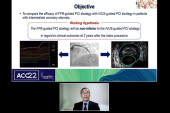Deferred PCI Equally Safe When Decision-making’s Based on IVUS vs FFR
As in the main FLAVOUR trial, deferrals had similar results no matter the tool used—FFR is still gold standard, a researcher says.

Patients whose PCI is deferred do equally well whether that’s a decision based on intravascular ultrasound or fractional flow reserve (FFR), according to a post-hoc analysis of 2-year data from the FLAVOUR trial. The results also were similar when analyzed at a lesion level.
FLAVOUR, as reported by TCTMD, was a randomized, head-to-head comparison of the two modalities—one assessing physiology, the other anatomy—in 1,682 patients with suspected ischemic coronary disease and intermediate stenosis on angiography (40% to 70%). The main 2-year results, released at the 2022 American College of Cardiology meeting, suggested that both are equivalent when used to guide treatment of patients with intermediate coronary stenoses.
Here, researchers homed in on the prognosis of deferred lesions.
Senior author Joo-Yong Hahn, MD, PhD (Samsung Medical Center, Seoul, Republic of Korea), told TCTMD said the subanalysis “supports the deferral of PCI based on IVUS findings is safe and feasible for intermediate coronary artery lesions.” Although more stents are needed with IVUS as compared with FFR guidance, there’s no harm seen here at the 2-year mark, he noted.
The FLAVOUR trial posed a unique question—could IVUS work as a gatekeeper to PCI, much like FFR? In its physiology-guided arm, the indications for PCI included an FFR ≤ 0.80. In its anatomy-guided arm, the indications included a minimal lumen area ≤ 3 mm2 (or > 3 but ≤ 4 mm2, plus plaque burden > 70%).
FFR for treatment decision-making and IVUS for procedural optimization would be the best strategy for PCI. Joo-Yong Hahn
Hahn noted that in real-world practice, operators already sometimes use IVUS in this way for left main lesions. “But for most non-left main lesions, FFR is considered a gold standard for treatment decision-making,” he added, and this remains the case following FLAVOUR.
Positive data continue to accrue showing the benefits of intravascular imaging over angiography as a way to optimize stent placement. Yet there’s still controversy over whether these tools are warranted in all cases.
More Stents but Similar Results
For this analysis, published recently in Circulation: Cardiovascular Interventions, the researchers focused on the 922 patients (989 vessels)—around 55% of the whole FLAVOUR cohort—whose PCI was deferred based on IVUS or FFR findings.
In FLAVOUR, 44.4% of the FFR group and 65.3% of the IVUS group underwent PCI. The mean total stent number per patient was 0.6 ± 0.9 with physiologic guidance and 0.9 ± 1.0 with anatomical guidance (P < 0.001).
Results were similar in deferred vessels no matter whether that decision had been based on IVUS (n = 375) or FFR (n = 614), with a 2-year cumulative incidence of vessel-oriented composite outcomes (cardiac death, target-vessel MI, or target revascularization) of 3.8% with IVUS and 4.1% with FFR (P = 0.77). For both IVUS and FFR, this incidence matched what was seen for revascularized vessels (3.5% and 3.6%, respectively, with P values of 0.81 and 0.72).
At a patient level, results also were similar regardless of whether the decision to defer had been based on IVUS (n = 357) or FFR (n = 565), with a 2-year cumulative incidence of patient-oriented composite outcomes (death, MI, or any revascularization) of 6.2% with IVUS and 5.9% with FFR (P = 0.86).
If both techniques—one imaging and one physiological—are comparable in terms of MACE, why do I need a tool that will lead to more stents? Rodrigo Bagur
Rodrigo Bagur, MD, PhD (London Health Sciences Centre, Western University, Canada), speaking with TCTMD, agreed it’s reassuring that IVUS offers comparable event rates to FFR in FLAVOUR. On the positive side, being able to use one tool for pre-PCI lesion assessment and post-PCI stent optimization could streamline procedures.
“However, we can clearly see that the use of IVUS leads to the use of more stents, and this is consistent with previous studies,” said Bagur, who co-wrote an editorial for the new paper along with Max W. Maffey, MBBS (London Health Sciences Centre, Western University), and Matthew A. Cavender, MD, MPH (University of North Carolina at Chapel Hill).
With deferral, essentially medical management, cardiovascular outcomes are similar between the two approaches, he noted. “You can ask yourself why, but if both techniques—one imaging and one physiological—are comparable in terms of MACE, why do I need a tool that will lead to more stents?” Stents carry the risk of restenosis and the need for dual antiplatelet therapy, Bagur pointed out.
Additionally, the population studied in FLAVOUR was low risk, with a mean SYNTAX score of 8.6. “So we cannot generalize these [findings] to all-comers. There might be some sort of selection for the initial inclusion of these patients in the trial,” he said. Other factors that might limit generalizability are the FLAVOUR trial’s “one-size-fits-all” cutoff for minimal lumen area in the IVUS arm as well as its enrollment of an exclusively Asian population.
Bagur stressed, though, that this doesn’t detract from intravascular imaging’s assets in stent optimization once operators have made the decision to pursue PCI.
As for clinical takeaways, Hahn summed up his advice on the heels of the FLAVOUR trial: “FFR for treatment decision-making and IVUS for procedural optimization would be the best strategy for PCI. However, use of IVUS for treatment decision-making as well as procedural optimization may be an alternative, especially cost-wise.”
Going forward, he said, it would be “valuable and interesting” to directly compare IVUS- and FFR-guided complete revascularization in ACS patients with multivessel disease. To do so, their research group recently launched the FRAME-AMI 2 trial.
Caitlin E. Cox is News Editor of TCTMD and Associate Director, Editorial Content at the Cardiovascular Research Foundation. She produces the…
Read Full BioSources
Lee JM, Kim H, Hong D, et al. Clinical outcomes of deferred lesions by IVUS versus FFR-guided treatment decision. Circ Cardiovasc Interv. 2023;16:e013308.
Maffey MW, Cavender MA, Bagur R. Deferring PCI based on IVUS assessment: on par with FFR or FLAVOUR of the week? Circ Cardiovasc Interv. 2023;16:e013649.
Disclosures
- Hahn reports receiving institutional research grants from the National Evidence-Based Healthcare Collaborating Agency, Abbott Vascular, Biosensors, Boston Scientific, Daiichi Sankyo, Donga-ST, Hanmi Pharmaceutical, and Medtronic.
- The editorialists report no relevant conflicts of interest.





Comments